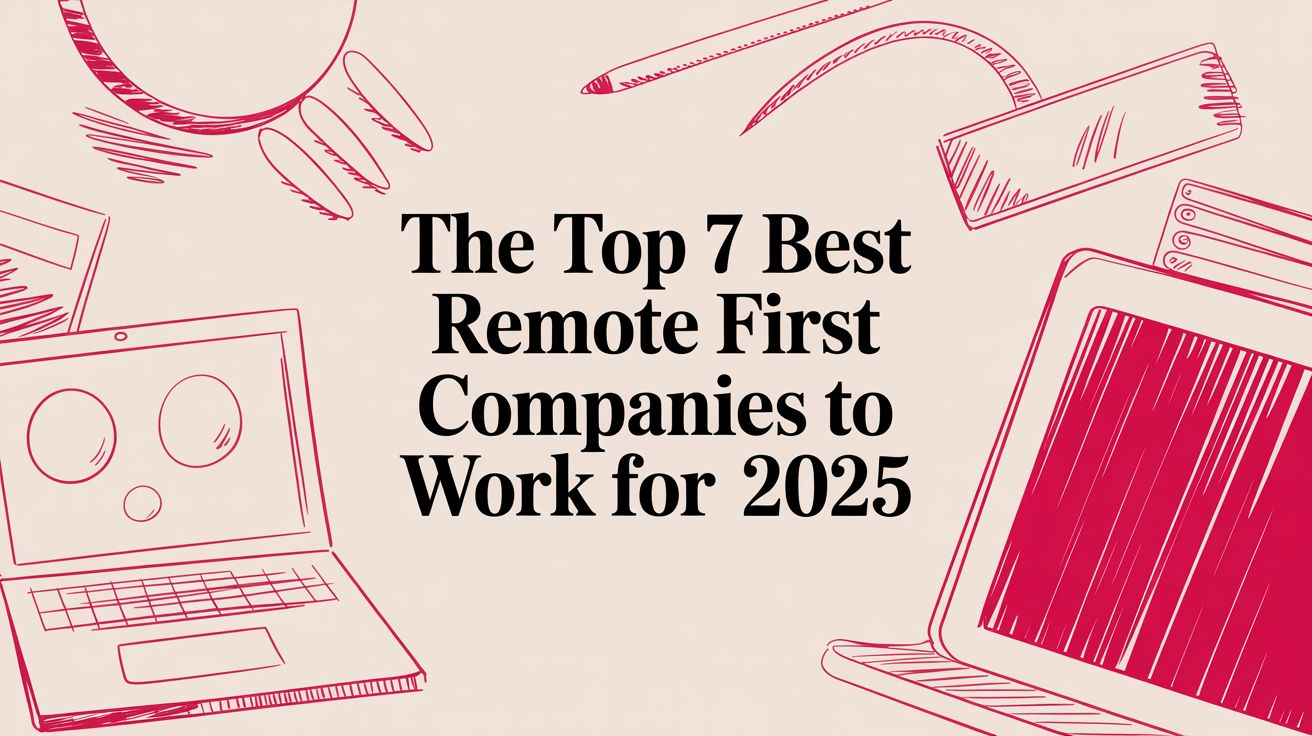What Is Inclusive Leadership? A Guide for Modern Teams
Max
Let’s cut through the noise. Inclusive leadership isn’t just about being nice—it’s an active strategy for unlocking a team’s full potential.
So, what is it, really? Simply put, it’s a leadership approach where you intentionally seek out, value, and integrate diverse perspectives to make smarter decisions. It’s all about making sure every single person feels heard, respected, and truly empowered to contribute their best work.
Understanding Inclusive Leadership Beyond the Buzzwords

Think of an inclusive leader as the conductor of a jazz ensemble, not a classical orchestra. A traditional conductor just directs musicians to play the notes exactly as written. But a jazz conductor? They listen to each instrument, embrace improvisation, and weave every unique sound together to create something far richer and more dynamic.
That distinction is everything. True inclusive leadership isn’t a one-and-done training session; it’s a constant, conscious effort to build an environment of psychological safety where every member of the team feels like they truly belong.
To give you a clearer picture, let’s compare it to a more traditional style.
Inclusive vs Traditional Leadership at a Glance
This table breaks down the core differences in how these two leadership styles show up in the workplace. You’ll notice the shift from top-down control to collective empowerment.
| Characteristic | Traditional Leadership | Inclusive Leadership |
|---|---|---|
| Decision-Making | Top-down; leader decides | Collaborative; seeks input from the team |
| Communication | One-way; directives are given | Two-way; encourages dialogue and feedback |
| Team Environment | Hierarchical and competitive | Safe, supportive, and collaborative |
| Handling Dissent | Discouraged; seen as a challenge | Encouraged; seen as an opportunity |
| Innovation | Stifled by conformity | Fueled by diverse perspectives |
| Focus | Processes and results | People and results |
As you can see, the inclusive approach is fundamentally about unlocking the collective intelligence of the entire team, rather than relying on the vision of a single person.
The Foundation of Inclusive Practices
At its core, inclusive leadership rests on a few key pillars. To really get it, it helps to understand the foundational principles of DEIB (Diversity, Equity, Inclusion, and Belonging). These ideas aren’t just HR buzzwords; they’re the bedrock of a thriving, inclusive culture.
An inclusive environment is one where:
- Contributions are valued: Everyone, no matter their role or background, feels their input is genuinely wanted and considered.
- Psychological safety is the norm: People feel safe enough to speak up, ask tough questions, or even admit mistakes without fearing blame.
- Opportunity is equitable: All individuals have a fair shot at resources, promotions, and chances to grow.
This approach moves beyond just hiring a diverse team; it’s about making sure that diversity actually thrives. The data doesn’t lie: companies with more diverse management teams generate, on average, nearly 19 percent more innovation revenue than their less-diverse peers.
The Impact on Global and Remote Teams
In a remote or hybrid setting, these principles aren’t just important—they’re mission-critical. When you lose the casual, in-person cues of an office, leaders have to be much more intentional about building connection and trust.
This is where sharpening your cross-cultural communication skills becomes non-negotiable for bridging the gaps between different time zones, cultures, and communication styles.
Ultimately, inclusive leadership is what transforms a scattered group of individuals into a tight-knit, high-performing team. It drives smarter decisions, sparks innovation, and creates a workplace where everyone is set up to win.
The Six Traits Of Highly Inclusive Leaders
Understanding inclusive leadership on paper is one thing; seeing it unfold day to day is another. Research points to six signature traits that top inclusive leaders share. These are not abstract goals but practical behaviors you can practice to strengthen team bonds.
Think of these traits as your roadmap from good intentions to genuine results. Step by step, they reveal what inclusion looks like in action. Let’s explore how each one plays out in a leader’s everyday toolkit.
1. Unwavering Commitment
Inclusive leadership always starts with a true, personal pledge. Saying “we value diversity” is easy; committing time, budget, and real energy is something else entirely. When you live this trait, it’s clear in your hiring decisions, the way you structure meetings, and your mentoring approach.
You don’t treat inclusion as an item on a to-do list. Instead, you weave it into every policy and conversation—making it an unmistakable part of your leadership DNA.
2. Courage And Vulnerability
Being brave isn’t just about big business calls; it’s about standing up when the room goes quiet. You call out a microaggression on the spot instead of letting it slide. You admit, “I don’t have all the answers,” and you own your mistakes.
These moments send a clear message: psychological safety is non-negotiable. Having these conversations can be challenging, and it’s important to learn how to handle difficult conversations with both empathy and directness.
Courage turns quiet support into active advocacy. It’s the spark that fuels real change.
3. Cognizance Of Bias
Bias lives in all of us, and the best leaders don’t pretend otherwise—they face it head on. Self-awareness is key: spotting blind spots that sneak into hiring, performance reviews, and feedback cycles. An aware leader puts checks in place to keep bias at bay, such as:
- Structured Interviews: Ask everyone the same set of questions to keep evaluations fair.
- Anonymous Resume Reviews: Strip out names and affiliations so you’re focused solely on skills.
- Diverse Interview Panels: Invite multiple viewpoints into every hiring discussion.
These simple steps help ensure each candidate gets a fair shake.
4. Genuine Curiosity
Inclusive leaders lean in with real questions rather than waiting to jump in with their own take. They listen to understand, not to respond. This openness encourages fresh ideas and gives people the confidence to share perspectives without fear.
When curiosity leads the conversation, team members feel heard—and innovation naturally follows.
5. High Cultural Intelligence
In a remote or global team, missing cultural cues is all too easy. Leaders with high cultural intelligence learn about different holidays, communication norms, and social etiquettes. They adapt their approach so every teammate feels seen and respected.
This simple awareness boosts morale and smooths collaboration across time zones and traditions.
6. Effective Collaboration
Finally, inclusion hinges on working well together. Truly inclusive leaders break down silos and make sure quieter voices are heard—and heeded. They set the stage for everyone to bring their best ideas to the table, unlocking the team’s collective potential.
By championing diverse viewpoints, these leaders turn individual strengths into shared success.
Why Inclusive Leadership Is a Business Imperative

Let’s be clear: inclusive leadership is no longer a soft skill or a cultural ideal. It’s a hard-hitting driver of business performance.
Organizations that get this right aren’t just creating better places to work—they’re building a serious competitive advantage. The conversation has moved far beyond the “nice-to-have” column and landed squarely in the “must-have” strategy book, with a clear, measurable impact on the bottom line.
When people feel genuinely valued and heard, their engagement, motivation, and loyalty skyrocket. This isn’t just feel-good fluff; it translates directly into lower turnover and higher productivity. A truly inclusive culture acts like a magnet for top talent, attracting skilled candidates who are actively seeking environments where they can do their best work.
Fueling Financial Performance
The numbers connecting diversity and profitability are impossible to ignore. Companies that lag in building diverse executive teams are taking a huge financial risk.
Think about this: by 2019, companies in the bottom quartile for gender diversity on their executive teams were 19% more likely to underperform on profitability. When you factor in both gender and ethnic diversity, that underperformance likelihood jumps to a staggering 27%.
This performance gap sends a clear message: homogeneity is a business risk. Inclusive leadership is the key to unlocking the full potential of a diverse team, which in turn leads to smarter decisions and better financial health.
The Power of Psychological Safety
So, what’s the secret ingredient driving these incredible results? It all comes down to psychological safety.
Inclusive leaders are masters at creating an atmosphere where team members feel secure enough to take smart risks, challenge the status quo, and toss out new ideas without fearing failure or ridicule. This environment is the absolute bedrock of innovation.
When people feel psychologically safe, they stop spending energy protecting themselves and start investing it in collaborative problem-solving. This shift unlocks creativity and boosts team performance, turning diverse perspectives into tangible business results.
This heightened engagement and reduced fear of failure have a direct, positive impact on keeping your best people around. It’s simple: environments where employees feel safe and valued see drastically lower turnover. You can learn more about this in our guide on how to improve employee retention.
Tapping Into a Wider Talent Pool
Finally, committing to real inclusion blows the doors off your traditional talent pool. To truly grasp why this is a business imperative, it’s worth exploring topics like the benefits of neurodiversity in the workplace.
When you build a culture that genuinely supports different ways of thinking and working, you can attract and retain exceptional talent that your competitors are completely overlooking.
This isn’t just an HR project. It’s a strategic imperative for sustainable growth.
How Inclusive Leaders Unleash Team Innovation

Inclusive leadership isn’t just about creating a feel-good workplace; it’s a powerful catalyst for breakthrough innovation. The connection is direct and profound. When leaders are intentionally open, accessible, and available, they cultivate the single most important ingredient for creativity: psychological safety.
Think of psychological safety as the invisible net under a high-wire act. When performers know the net is there, they feel secure enough to try daring, complex maneuvers. Without it, they stick to the simple, predictable stuff. The same goes for your team.
An inclusive leader provides that net. They make it safe for people to experiment, challenge the status quo, and share off-the-wall ideas without fearing failure or ridicule. This safety completely transforms how a team operates.
The Feedback Loop of Valued Contribution
This dynamic creates a powerful, self-reinforcing cycle of engagement and innovation. Inclusive leaders don’t just let people talk; they actively make sure every voice is heard, especially from those who are often overlooked.
Imagine this scenario playing out in a real meeting:
- A junior team member hesitantly offers a critique of the current strategy.
- Instead of brushing it off, the inclusive leader pauses the discussion to dig into the idea, asking thoughtful questions.
- When the idea proves valuable and gets integrated, the leader gives public credit to that junior employee, showing everyone that all contributions matter.
That small act sends a huge message. The individual feels seen and is motivated to contribute again. Other team members witness this and realize their input is genuinely wanted, encouraging them to speak up, too. This positive feedback loop unlocks a wellspring of ideas that would otherwise stay hidden.
This leadership style is defined by its ability to strengthen team psychological safety, which is essential for creative risk-taking. When employees see their leaders as inclusive and supportive, studies show they reciprocate with increased innovative performance. You can explore more about the research behind leadership and innovation.
Building the Foundation of Trust
At the end of the day, innovation thrives on trust. Inclusive behaviors are the building blocks of that trust, especially in a distributed workforce.
When a leader is consistently accessible and open, they demonstrate reliability and build strong relationships. This foundation is absolutely critical for remote teams, where those informal, “water cooler” connections are much harder to build naturally. By learning more about building trust in virtual teams, leaders can ensure their inclusive practices work just as well across any distance.
Actionable Steps to Cultivate Inclusive Leadership

Knowing what inclusive leadership is gets you to the starting line. But real change only happens when you translate those big ideas into the small, everyday things you do. Becoming an inclusive leader isn’t a destination you arrive at; it’s a journey of intentional practice.
It means actively building new habits and taking a hard look at old systems that might be shutting people out without anyone even realizing it. The following steps are a practical toolkit for any manager ready to put theory into action.
Conduct an Unconscious Bias Audit
The first and most important step is to look in the mirror. We all have unconscious biases—they’re mental shortcuts our brains use that can accidentally steer our decisions on everything from hiring to promotions. An audit is just a systematic way of looking at your team’s processes to spot where these biases might be creating an unfair playing field.
Start by examining your hiring process. Are your job descriptions accidentally using gendered language? Do you rely too heavily on referrals, which often just bring in more of the same? Simple changes like using structured interviews and blind resume reviews can make a massive difference right away. You can learn more about building equitable systems in our guide to fair hiring practices.
Redesign Meeting Structures for Equal Voice
Meetings are where inclusion often lives or dies. Think about it: a typical, unstructured meeting is a perfect environment for the loudest or most senior people to dominate the conversation, leaving incredible insights on the table.
To fix this, you have to be deliberate about redesigning your meeting formats.
Try these tactics:
- Rotate Facilitators: This simple change stops one person from always controlling the flow and gives others a chance to step up and lead.
- Use Silent Brainstorming: Before anyone speaks, ask the group to jot down ideas individually on sticky notes or in a shared doc. This ensures everyone’s initial thoughts are captured, not just the first person’s.
- Implement a ‘No-Interruption’ Rule: Actively moderate the discussion to make sure people can finish their thoughts. It fosters a much more respectful and thoughtful exchange.
Champion Employee Resource Groups
Employee Resource Groups (ERGs) are employee-led groups that create a safe space for people with shared backgrounds or life experiences to connect. They are absolute goldmines for building a diverse, inclusive culture.
As a leader, your job isn’t just to approve ERGs—it’s to champion them. That means giving them a real budget, a platform to share their insights with senior leadership, and actually acting on their feedback. When you give ERGs real support, they become powerful partners in creating a place where everyone feels like they truly belong.
Globally, only about 5% of leaders currently meet the criteria for inclusive leadership, revealing a massive opportunity for growth. The cost of inaction is high, as 31% of U.S. employees report feeling excluded at work, and a concerning 55% of them are considering leaving their jobs as a result. You can discover more insights about inclusive leadership statistics to understand the urgency.
Frequently Asked Questions About Inclusive Leadership
Even when you have a good handle on the theory, putting inclusive leadership into practice can bring up some tricky questions. Let’s tackle some of the most common ones that pop up when leaders start this journey.
How Is Inclusive Leadership Different From Just Being a Nice Manager?
It’s a great question, and the difference is huge. Being a “nice” manager is often about being pleasant and agreeable. Inclusive leadership, on the other hand, is about being intentional and strategic.
Think of it this way: niceness is often passive. An inclusive leader is active. A nice manager might avoid conflict to keep everyone happy. An inclusive leader steps into uncomfortable conversations—like addressing a microaggression—to ensure the team’s psychological safety is protected. It’s the difference between being a friendly bystander and being an active advocate for every single person on your team.
Can Inclusive Leadership Be Learned, or Is It an Innate Trait?
Inclusive leadership is 100% a learned skill. While some people might naturally be more empathetic or curious, the core competencies are built through deliberate effort, self-awareness, and a lot of practice. Nobody is born a perfect inclusive leader.
The key traits—like understanding your own biases, developing cultural intelligence, and finding the courage to speak up—all come from a real commitment to personal growth. It means being willing to look in the mirror, make mistakes, and learn from them. Organizations can support this by offering training on unconscious bias, providing leadership coaching, and creating a culture where inclusive actions are seen and rewarded.
Inclusive leadership isn’t about having all the answers. It’s about having the humility to ask the right questions and the courage to act on what you learn.
How Can I Measure the Impact of Inclusive Leadership on My Team?
You can’t improve what you don’t measure. Tracking the impact of inclusive leadership requires looking at both the hard numbers and the human experience.
On the quantitative side, you can look at key metrics like:
- Employee Turnover Rates: Are you losing people from underrepresented groups at a higher rate? That’s a huge red flag.
- Promotion Rates: Dig into the data. Are promotions being distributed equitably across different demographics?
- Engagement Survey Scores: Look for high scores on questions about belonging, psychological safety, and feeling valued.
But the numbers only tell half the story. The qualitative side is just as important. Use anonymous pulse surveys to get honest feedback. Conduct “stay interviews” to find out what keeps your best people around. And just pay attention—are more voices being heard in meetings? Is the team collaborating more effectively? When you combine these observations with the data, you get a true picture of your impact.
Does Inclusive Leadership Work in a Fast-Paced, Results-Driven Environment?
Absolutely. In fact, it’s arguably more critical in high-pressure environments. There’s a common myth that being inclusive slows things down, but it’s just not true. When you create a space where every idea is heard, you spot the best solutions faster and avoid the costly blind spots that come from a lack of diverse perspectives.
Inclusive leadership is your best defense against groupthink. It fuels the kind of innovative problem-solving you need to stay ahead when the pressure is on. It’s not a “nice-to-have”; it’s an investment in a more agile, resilient, and higher-performing team that delivers better results, especially when it matters most.
Ready to build a career with a company that values your unique perspective? At Remote First Jobs, we connect talented professionals with forward-thinking companies that understand the power of inclusive leadership. Explore over 40,000 genuine remote opportunities and find a workplace where you can truly thrive. Find your next role at https://remotefirstjobs.com.


